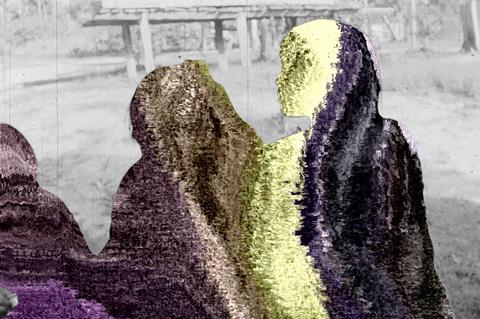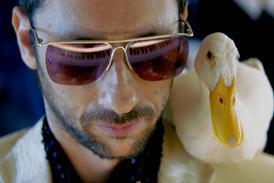
Paula Albuquerque’s Like The Glitch Of A Ghost has been the only Portuguese film in the international competition at Doclisboa this week. An experimental, archive-based documentary, it uses footage from a Dutch religious short shot in Suriname in the 1950s but edits this footage in a polemical way that lays bare the colonial mindset behind the short.
The documentary is an example of ‘glitch art.’ What seem to be technological errors in the film are, in fact, carefully considered aesthetic decisions.
The white Dutch woman, a nun and teacher, who is the subject of the film, is depicted clearly but the Surinamese villagers are shown as eerie, ghostly presences whose bodies appear blurred. Working with artist José Miguel Biscaya, the director meshes images from contemporary surveillance cameras in Suriname with the footage of the indigenous people.
“Normally my projects take two to three years and there is this artistic research process that I go through,” says the Portuguese but Dutch-based artist, filmmaker and academic who teaches at the University of Amsterdam and Gerrit Rietveld Academy. Her work has been shown at festivals including International Film Festival Rotterdam and in museums and galleries.
Colonial archive

Like The Glitch Of A Ghost was inspired by research Albuquerque undertook at Eye Filmmuseum in Amsterdam with the encouragement of Giovanna Fossati, Chief Curator at the Museum and professor of film heritage and digital film culture at the University of Amsterdam.
Albuquerque concentrated on the colonial section of the archive, looking through travelogues, propaganda films and home movies kept in Eye’s “Small Film” collection.
In her work, she often focuses on representations of what she calls “the exhausted body, the burned out body.”
“You notice there is a huge difference in how the body of the white male is represented when exhausted…and when we look at BIPOC [Black, Indigenous, and People of Colour]. Then, the body is always, poor, dirty, sick. It’s always in relation to slavery or colonialism, or in positions of servitude.”
During research, Albuquerque “bumped into” the Suriname footage she uses in her documentary. The footage was made through the Algemeen Diakonaal Bureau of the Reformed Churches. The first image is of a white woman (the nurse/nun) bathing in the waters with indigenous people.
“I was moved and shocked to see she is the only one wearing a bathing suit. She looks very clean and she has a good haircut. All these people around her are in rags. I thought I really want to show this but I cannot show their bodies. I cannot again perpetuate this colonising gaze in which we are again belittling these people…treating them as ignorant, as children.”
Albuquerque decided to “mask” the bodies and to ensure that the “colour of the skin was really blocked and is not visible because of the glitching. We all know that [such a] film has been made as a means of racialising people, of ‘othering’ people.”
Glitch art technique
This is where the glitch art comes in. The indigenous people are camouflaged digitally, so their bodies and faces are blurred and indistinct and are viewed as abstract shapes. “The digital data of the bodies are fused with [footage from] surveillance cameras that are filming right now in the same area,” explains the director about how the effect was achieved.
The white woman is depicted as the do-gooder, teaching the poor, ignorant locals about the virtues of western, Dutch civilisation. “The Europeans are presented as the helpers of these people who are being portrayed as being extremely under-developed and not able to take care of themselves. Justifying the politics of dispossession - that is what these films were doing.”
At screenings this week in Doclisboa, the film has provoked “extremely positive” but quizzical reactions from festival goers. “People are baffled because they are really trying to understand what it is that they are seeing. They are completely fascinated by the ‘glitch’ itself. People consider it a very beautiful object,” Albuquerque says of the responses. She has been told by some viewers that the film is “showing people colonialism like they have never seen it before.”
The Doclisboa premiere follows on from a Union Docs Artistic Differences work in progress screening held in the Netherlands earlier this summer where there was a more polemical reaction to the doc. Viewers there were concerned that Albuquerque was “taking away the identity” of the indigenous people. She counters such an argument by pointing out that these people were anonymous in the original film - and this is what she wanted to emphasise.
Albuquerque’s mother was born in Mozambique and her father in Goa in India, “both descendants from Portuguese settlers,” she points out. “All my works is about the colonial, always.”
Like The Glitch Of A Ghost was funded by arts organisations, among them Eye Filmmuseum, Mondrian Fund, Creative Industries Fund NL and the Amsterdam Fund for the Arts. It will be seen in the Netherlands as part of a solo exhibition of Albuquerque’s work in Amsterdam next month.
Doclisboa runs from Oct 19 to Oct 29.






![The Brightest SunScreen[Courtesy HKIFF]](https://d1nslcd7m2225b.cloudfront.net/Pictures/274x183/3/5/0/1448350_thebrightestsunscreencourtesyhkiff_312678.jpg)


















No comments yet